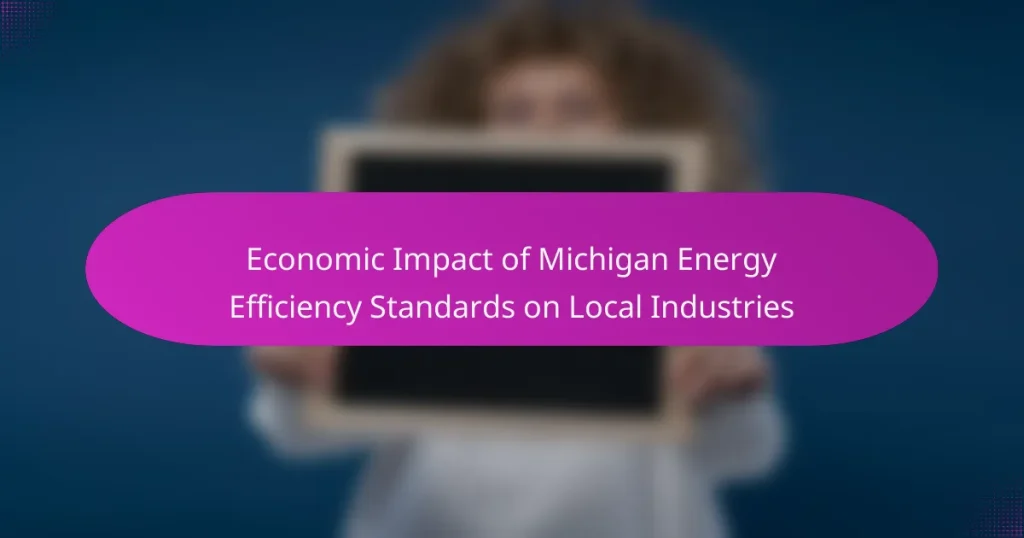
What are Michigan Energy Efficiency Standards?
Michigan Energy Efficiency Standards are regulations designed to promote energy conservation and improve energy efficiency across various sectors. These standards apply to residential, commercial, and industrial buildings. They set minimum efficiency requirements for appliances, lighting, and HVAC systems. The standards aim to reduce energy consumption and lower utility costs for consumers. They also contribute to environmental sustainability by decreasing greenhouse gas emissions. Michigan’s standards are part of a broader initiative to enhance energy efficiency statewide. Research indicates that these standards have led to significant energy savings and economic benefits for local industries.
How were these standards developed?
These standards were developed through a collaborative process involving various stakeholders. Key participants included government agencies, industry representatives, and environmental organizations. They conducted extensive research on energy consumption and efficiency metrics. Public consultations allowed for input from local communities and businesses. The process also included benchmarking against national and international standards. Data analysis highlighted potential economic benefits and energy savings. The final standards aimed to balance energy efficiency with economic growth. This comprehensive approach ensured that the standards were both effective and applicable to Michigan’s unique industrial landscape.
What stakeholders were involved in the creation of these standards?
The stakeholders involved in the creation of Michigan’s energy efficiency standards include state government agencies, industry representatives, and environmental organizations. State government agencies, such as the Michigan Public Service Commission, played a key role in developing the standards. Industry representatives contributed insights on feasibility and implementation. Environmental organizations advocated for stronger efficiency measures to reduce carbon emissions. Together, these stakeholders collaborated to ensure that the standards balanced economic growth and environmental sustainability.
What legislative framework supports these standards?
The legislative framework supporting Michigan’s energy efficiency standards includes the Clean, Renewable, and Efficient Energy Act of 2008. This act mandates energy savings targets for utilities. It requires utilities to implement energy optimization plans. These plans aim to reduce energy consumption and promote efficiency. The framework also includes the Public Utility Regulatory Policies Act (PURPA). PURPA encourages utilities to adopt cost-effective energy efficiency measures. Furthermore, the Michigan Public Service Commission oversees compliance with these standards. This oversight ensures that utilities meet their energy savings goals.
What is the purpose of Michigan Energy Efficiency Standards?
The purpose of Michigan Energy Efficiency Standards is to promote energy conservation and reduce energy consumption. These standards aim to lower energy costs for consumers and businesses. They also seek to minimize environmental impact by reducing greenhouse gas emissions. Additionally, the standards encourage the adoption of energy-efficient technologies. By implementing these standards, Michigan aims to improve overall energy efficiency in various sectors. This, in turn, supports economic growth and job creation in the energy efficiency industry.
How do these standards aim to reduce energy consumption?
These standards aim to reduce energy consumption by establishing efficiency benchmarks for appliances and equipment. They require manufacturers to produce energy-efficient products that consume less power during operation. For example, the standards may mandate specific energy use limits for lighting, heating, and cooling systems. This leads to reduced electricity demand, which can lower utility costs for consumers. The implementation of these standards has been shown to decrease overall energy usage in households and businesses. According to the Michigan Public Service Commission, energy efficiency programs have saved over 1 billion kilowatt-hours annually since their inception. This significant reduction in energy consumption contributes to lower greenhouse gas emissions and promotes sustainable energy practices.
What environmental impacts are associated with these standards?
The environmental impacts associated with Michigan’s energy efficiency standards include reduced greenhouse gas emissions and lower energy consumption. These standards promote the use of energy-efficient technologies. As a result, they decrease reliance on fossil fuels. This leads to cleaner air and improved public health outcomes. Studies indicate that energy efficiency measures can cut carbon emissions significantly. For example, the American Council for an Energy-Efficient Economy reported that such standards could lead to a reduction of over 15 million metric tons of CO2 annually in Michigan. Additionally, the standards help conserve water resources by reducing the need for cooling in power plants. Overall, these standards contribute to a more sustainable environment.

What is the economic impact of Michigan Energy Efficiency Standards on local industries?
The economic impact of Michigan Energy Efficiency Standards on local industries is significant. These standards promote energy-saving practices that reduce operational costs for businesses. Lower energy consumption leads to decreased utility expenses. Consequently, industries can allocate savings toward growth and innovation.
In 2020, Michigan’s energy efficiency initiatives saved over 1.3 billion kilowatt-hours. This saving translates to approximately $150 million in reduced energy costs for businesses. The standards also create jobs in the energy efficiency sector. According to the Michigan Public Service Commission, energy efficiency programs support over 5,000 jobs statewide.
Overall, Michigan Energy Efficiency Standards foster a more sustainable and economically viable industrial landscape.
How do these standards affect operational costs for local businesses?
Energy efficiency standards directly reduce operational costs for local businesses. By implementing these standards, businesses lower energy consumption. This leads to decreased utility bills. For example, a study by the American Council for an Energy-Efficient Economy found that businesses can save up to 30% on energy costs. Additionally, energy-efficient equipment often requires less maintenance. This further reduces long-term expenses. Overall, compliance with energy efficiency standards promotes cost savings and enhances profitability for local businesses.
What specific cost savings can businesses expect?
Businesses can expect significant cost savings from Michigan’s energy efficiency standards. These standards can reduce energy consumption by up to 25%. Lower energy use directly translates to reduced utility bills. For example, a manufacturing facility could save approximately $30,000 annually. Additionally, businesses may benefit from incentives and rebates for energy-efficient upgrades. These financial incentives further enhance overall savings. Studies show that energy efficiency improvements lead to a return on investment of up to 200%. Such financial benefits contribute positively to the bottom line of local industries.
How do energy efficiency initiatives influence pricing strategies?
Energy efficiency initiatives influence pricing strategies by reducing operational costs for businesses. When companies invest in energy-efficient technologies, they often experience lower energy bills. This reduction in expenses can enable businesses to offer more competitive pricing.
For example, a study by the American Council for an Energy-Efficient Economy (ACEEE) found that businesses implementing energy efficiency measures saved an average of 20% on energy costs. This savings can be passed on to consumers through lower prices.
Additionally, energy efficiency initiatives can enhance a company’s market position. Businesses that prioritize sustainability may attract environmentally conscious consumers. This can lead to increased sales and market share, further influencing pricing strategies.
Overall, energy efficiency initiatives create a favorable economic environment that can lead to more competitive pricing.
What industries are most affected by these standards?
The industries most affected by Michigan Energy Efficiency Standards include manufacturing, construction, and utilities. Manufacturing industries face increased operational costs due to compliance with energy efficiency regulations. Construction companies must adapt to new building codes that promote energy-efficient designs. Utilities are impacted as they adjust their energy supply and demand strategies to meet efficiency targets. These changes can lead to higher costs and shifts in market dynamics. According to the Michigan Public Service Commission, energy efficiency standards can significantly influence operational practices across these sectors.
Which sectors are experiencing the greatest changes?
The sectors experiencing the greatest changes due to Michigan’s energy efficiency standards are manufacturing, construction, and utilities. Manufacturing is adapting to new energy regulations, leading to increased investment in energy-efficient technologies. The construction sector is shifting towards sustainable building practices and materials to comply with efficiency mandates. Utilities are restructuring their operations to meet renewable energy targets and improve energy distribution. These changes are driven by the need to reduce energy consumption and lower greenhouse gas emissions. According to the Michigan Energy Office, these sectors are vital in achieving the state’s energy goals.
How do these standards impact small vs. large enterprises?
Energy efficiency standards significantly affect small and large enterprises differently. Small enterprises often face higher relative costs to comply with these standards. They may lack the resources for upfront investments in energy-efficient technologies. In contrast, large enterprises typically have better access to capital and can spread compliance costs over a larger output.
According to a study by the American Council for an Energy-Efficient Economy, small businesses may experience a greater financial burden due to limited budgets. Large firms can leverage economies of scale to implement energy-efficient measures more efficiently. The standards can stimulate competition, benefiting larger enterprises that can innovate quickly.
However, small enterprises may also find opportunities in niche markets created by these standards. Overall, while large enterprises may adapt more easily, small enterprises face unique challenges and opportunities in the context of energy efficiency standards.

What are the broader implications of Michigan Energy Efficiency Standards on the local economy?
Michigan Energy Efficiency Standards positively impact the local economy. These standards promote energy conservation, reducing overall energy costs for businesses and consumers. Lower energy expenses enhance disposable income and stimulate local spending. Additionally, energy efficiency initiatives create jobs in retrofitting and installation sectors. According to a 2020 report from the Michigan Public Service Commission, energy efficiency programs generated over 3,000 jobs statewide. Furthermore, increased energy efficiency attracts businesses looking for cost-effective operational environments. This leads to greater economic stability and growth within the community. Overall, these standards contribute to a more sustainable and economically vibrant Michigan.
How do these standards foster job creation in local industries?
Michigan energy efficiency standards foster job creation in local industries by promoting investment in energy-saving technologies. These standards encourage businesses to adopt more efficient practices, which often require skilled labor for installation and maintenance. For instance, the implementation of energy-efficient systems has led to an increase in demand for electricians and HVAC technicians. According to a report by the American Council for an Energy-Efficient Economy, energy efficiency investments can create up to 17 jobs for every million dollars spent. This demonstrates a direct correlation between energy efficiency standards and job growth in the local economy. Additionally, local manufacturers benefit from increased demand for energy-efficient products, further stimulating job creation in production and supply chain sectors.
What types of jobs are being created as a result of these standards?
The types of jobs being created as a result of Michigan’s energy efficiency standards include positions in energy auditing, installation of energy-efficient systems, and manufacturing of energy-efficient products. Energy auditors assess buildings for efficiency improvements. Installers work on HVAC systems, insulation, and lighting upgrades. Manufacturers produce energy-efficient appliances and materials. The implementation of these standards has led to a growth in green jobs, contributing to the local economy. A report from the Michigan Public Service Commission indicated that energy efficiency initiatives have created thousands of jobs in recent years.
How does job growth correlate with energy efficiency initiatives?
Job growth positively correlates with energy efficiency initiatives. Implementing energy efficiency programs often leads to increased demand for skilled labor. For example, the American Council for an Energy-Efficient Economy reported that energy efficiency investments create more jobs per dollar spent compared to fossil fuel investments. In Michigan, energy efficiency initiatives have been linked to thousands of new jobs in the construction and manufacturing sectors. Additionally, the Michigan Energy Office found that energy efficiency programs contributed to a significant rise in employment opportunities. This relationship highlights how energy efficiency not only conserves resources but also stimulates local economies through job creation.
What challenges do local industries face in adapting to these standards?
Local industries face several challenges in adapting to Michigan’s energy efficiency standards. Compliance with new regulations requires significant investment in technology upgrades. Many businesses struggle with the financial burden of these changes. Training employees to operate new systems adds to operational costs. Additionally, the complexity of the standards can lead to confusion and misinterpretation. Smaller firms often lack the resources to effectively implement necessary changes. Delays in obtaining permits or approvals can hinder timely compliance. Finally, competition from out-of-state businesses not subject to the same standards poses a further challenge.
What are common barriers to compliance for businesses?
Common barriers to compliance for businesses include lack of resources, unclear regulations, and insufficient training. Many businesses struggle with limited financial and human resources needed to implement compliance measures. Unclear regulations can lead to confusion regarding what is required for compliance. Insufficient training for employees can result in non-compliance due to lack of knowledge. Additionally, resistance to change within the organizational culture can hinder compliance efforts. These barriers often lead to increased costs and potential penalties for businesses.
How can businesses overcome these challenges effectively?
Businesses can overcome challenges related to Michigan energy efficiency standards by adopting innovative technologies. Implementing energy-efficient equipment can reduce operational costs significantly. Training employees on energy management practices enhances overall efficiency. Collaborating with local energy providers can provide access to resources and incentives. Seeking government grants or subsidies can help offset initial investment costs. Regularly reviewing energy consumption can identify areas for improvement. These strategies can lead to a sustainable business model while complying with energy standards. According to the Michigan Energy Office, businesses that implement efficiency measures can save an average of 20% on energy costs.
What best practices can local industries adopt to align with Michigan Energy Efficiency Standards?
Local industries can adopt several best practices to align with Michigan Energy Efficiency Standards. First, they should conduct energy audits to identify areas for improvement. These audits help pinpoint inefficiencies in energy use. Second, industries should implement energy-efficient technologies. Upgrading to LED lighting and high-efficiency HVAC systems can significantly reduce energy consumption. Third, staff training is essential. Educating employees on energy-saving practices fosters a culture of efficiency.
Additionally, industries should utilize renewable energy sources. Solar panels and wind turbines can help meet energy needs sustainably. Collaborating with local utilities for incentives and rebates is also beneficial. Such partnerships can lower costs for energy-efficient upgrades. Finally, monitoring and reporting energy usage regularly ensures ongoing compliance with standards. This practice allows for adjustments to maintain efficiency.
What strategies can businesses implement for better energy management?
Businesses can implement several strategies for better energy management. First, they should conduct energy audits to identify inefficiencies. Energy audits provide insights into energy consumption patterns. Next, businesses can invest in energy-efficient technologies. Utilizing LED lighting and high-efficiency HVAC systems significantly reduces energy usage. Additionally, implementing a smart energy management system allows for real-time monitoring. This technology helps optimize energy consumption based on demand. Employee training on energy conservation practices is also crucial. Educating staff on energy-saving behaviors can lead to substantial reductions in waste. According to the U.S. Department of Energy, companies that adopt these strategies can see energy savings of 10-30%.
How can industries leverage incentives to improve energy efficiency?
Industries can leverage incentives to improve energy efficiency by implementing programs that promote energy-saving technologies. Financial incentives, such as tax credits and rebates, encourage businesses to invest in energy-efficient equipment. Utility companies often provide incentives for reducing energy consumption, which can lead to cost savings.
Additionally, grants and funding opportunities are available for projects focused on energy efficiency improvements. Research indicates that industries participating in incentive programs can achieve energy savings of 10-30%. For instance, a study by the American Council for an Energy-Efficient Economy found that businesses that utilized energy efficiency incentives reported significant reductions in operational costs. This demonstrates that leveraging incentives effectively can lead to enhanced energy efficiency and economic benefits for industries.
Michigan Energy Efficiency Standards are regulations aimed at enhancing energy conservation and efficiency across residential, commercial, and industrial sectors. This article explores the economic impact of these standards on local industries, highlighting the significant energy savings, cost reductions, and job creation resulting from their implementation. It also examines the collaborative development process involving various stakeholders, the legislative framework supporting these standards, and the challenges faced by businesses in adapting to compliance. Additionally, the article discusses best practices and strategies for leveraging incentives to improve energy efficiency, ultimately contributing to a more sustainable and economically viable Michigan.


